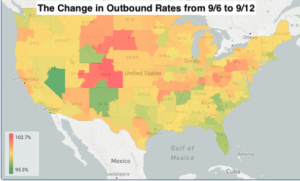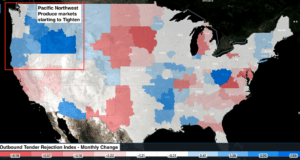Transfix Take Podcast | Ep. 67 – Week of September 14
Driver Appreciation Week
Drivers are the backbone of our economy; throughout the pandemic, they were among the frontline workers who finally got their time in the spotlight. Trucking is actually one of the most common occupations: out of approximately 158 million working adults in the United States, well over 3 million of those workers are truck drivers. Even though being a trucker is one of the most common jobs, most people still don’t realize how demanding a lifestyle it is. Life as an over-the road truck driver can be difficult when driving over 100,000 miles a year, to say nothing of spending more nights of the year away from one’s home than in it. And for many drivers, those nights are spent on a twin-size mattress in the sleeper cab of a truck.
As we continue to navigate freight, Transfix also pushes to improve the lives of truckers and their time on the road. Be sure to check out the second annual TransFIX My Rig event, a contest where truckers are nominated to win a dream renovation of their sleeper cab. This year’s winner, Jess Graham, had the big reveal of her rig on Tuesday.
In the past seven days, truckload markets have remained quiet, and we haven’t witnessed much change in spot rates or capacity. However, we should anticipate that the Pacific Northwest will heat up in the coming weeks, as it is the time of year this region experiences an increase in produce volume. With increased produce volume, we will usually see pressure hit reefer capacity before spreading to dry van as we get further into Q4. As truckload markets continue to favor shippers, we recognize that it would take a lot to change the rate momentum back in favor of carriers. The holiday season usually presents an opportunity for such a momentum shift, but this year, it probably won’t– not unless issues in other parts of the supply chain impact the truckload sector.

Source: Transfix

Source: FreightWaves, SONAR
How Low Can They Go?
Tender rejections, like spot rates, haven’t made much noise . . . but they are continuing their slow decline. The question is, where will they bottom out? Can they make it below 5%? Tender rejections sit at 5.24% nationally, the lowest they have been since the start of the pandemic. I do not see them going significantly lower than they are at present. We are starting to hit the floor on spot rates.
The declining contract rates could end up putting some pressure on the spot market, as contract rates become less lucrative over time – this could start the vicious pricing cycle our industry is accustomed to. Due to less shipping demand, contract rates took a dive in August, which caused the spot market to begin its fall off a cliff in March, prompting shippers to reprice lanes.
With contract rates declining, spot rates could increase in the back half of October. In March, we saw those spot rates hit their all-time high and then start to drive downward. However, even though spot rates started to fall, contract rates continued to rise, also hitting all-time highs. Over the summer, shippers started renegotiating their contract rates and, through August, they were able to push down contract prices in a notable way. Contract rates remain above spot, but now that the gap has been closing, we could see more freight make its way into the spot market if smaller disruptions were to occur in specific markets.
We also continue to keep an eye on the weather, as the past few weeks have been pretty active, including multiple named storms in the Atlantic. A major hurricane or a continuation of issues at East Coast ports could wind up being the factor that pushes more freight into the spot market.

Source: FreightWaves, SONAR
Rail Strikes
The past week’s industry headlines have centered around the potential rail union strike that might occur at the end of this week. Currently, ten of the twelve unions have come to an agreement, but the remaining two unions are the largest. If an agreement is not made by Friday, the two sides could strike or may agree to extend the “cooling-off period” until mid-October.
Because rail is a major artery of the U.S. supply chain, Congress could take action to prevent a strike if these parties are not able to reach an agreement. Some railroads took action this past Friday by starting to cut back service, out of fears that a strike could leave cargo abandoned on rails across the country. This means we might see some of this freight spill into the truckload market. I am still doubtful that a possible strike will impact the truckload markets in a significant way, but there certainly is potential. East Coast ports are still battling an oversupply of empty containers and lack of chassis, and additional rail issues could worsen this problem.
Again, I remain optimistic and do not believe we’re going to see a tightening of the truckload market throughout the month of September. However, Q4 could potentially be a different story if these issues continue to bottle up and gain more momentum.
The movement of freight is changing in every mode, as shippers do their best to keep up with record demand while fighting congestion at multiple points throughout the supply chain. Shippers who think forward, use data and think outside the proverbial box on solutions, while partnering with companies such as Transfix, will come out of this ongoing freight rally in a better position and well ahead of competitors. The one huge win through this pandemic has been speeding up the digital transformation of the transportation industry.
With the uncertainty and volatility surrounding the U.S. economic recovery, shippers need a partner that can help them adapt and excel — no matter the circumstance. Shippers turn to Transfix for our leading technology and reliable carrier network. As volumes drive higher, we are here to help: Learn more about our Core Carrier program and Dynamic Lane Rates. As part of our ongoing market coverage, we’ll continue to provide breaking news, resources and insight into emerging trends and the pandemic’s impact on the transportation industry.
Disclaimer:
All views and opinions expressed in this blogpost are those of the author and do not necessarily reflect the views or positions of Transfix, Inc. or any parent companies or affiliates or the companies with which the participants are affiliated, and may have been previously disseminated by them. The views and opinions expressed in this blogpost are based upon information considered reliable, but neither Transfix, Inc. nor its affiliates, nor the companies with which such participants are affiliated, warrant its completeness or accuracy, and it should not be relied upon as such. In addition, the blogpost may contain forward-looking statements that are not statements of historical fact. All such statements are based on current expectations, as well as estimates and assumptions, that although believed to be reasonable, are inherently uncertain, and actual results may differ from those expressed or implied. All views, opinions, and statements are subject to change, but there is no obligation to update or revise these statements whether as a result of new information, future events, or otherwise.




